|
The attention of Counsel
is directed to the following Acts of the Legislature of Scotland before
the Union with England:—
1st. Act 1st William and Mary, dated 22nd July, 1689, Whereby the
Legislature of Scotland abolished “Prelacy and Episcopal
Jurisdiction.”—[Scotch Acts of Parliament, vol. ix., page 104, intituled
“ An Act for abolishing ‘ Prelacie.’ ”]
2nd. An Act ratifying the Confession of Faith, dated 7th July,
1090.—[2nd Will, and Mary, 7th July, 1G90, vol. ix., p. 117.]
3rd. An Act for settling the peace and quiet of the Church, and
declaring the Presbyterian Church Government and Discipline “to be the
only Government of Christ’s Church w7ithin [that] kingdom.”—[3rd Will,
and Mary, 12th June, 1693, vol. ix., p. 303.]
Counsel’s attention is also directed to the following Acts of the United
Kingdom:—
1.
Act for an Union of the two kingdoms of England and Scotland, ratifying
the before-mentioned Acts abolishing Prelacy and establishing the
Presbyterian Government as the only Government of the Church within the
kingdom of Scotland in terms of the articles of Union between the two
kingdoms.—[5 and 0 Anne, cap. 8 (1706).]
2.
Act 10 Anne, cap. 7, Whereby Toleration was granted to “congregations”
to meet and assemble for the exercise of Divine worship to be performed
after their own manner by Pastors ordained by a Protestant Bishop.” And
such Assemblies are designated as “Episcopal meetings and
congregations.”—[10 Anne, cap. 7 (1711).]
3.
Also, to the four following Penal Acts chiefly directed against the Non-juring
Episcopal clergymen and congregations in Scotland:—
5 Geo. I. cap. 29 (1718).
19 Geo. II. cap. 38 (1740).
19 Geo. II. cap. 39 (1746).
21 Geo. II. cap. 34 (1748).
4.
Also, to the following Act partially repealing penalties, 32 Geo. 111.
cap. 03 (1792) intituled, “An Act for granting relief to Pastors,
Ministers, and Lay Persons of the Episcopal Communion in Scotland.”
5.
Also, to 3 and 4 Viet. cap. 33 (1840), commonly called Bishop
Blomfield’s Act.
14 and 15 Viet. cap. 00 (1851), Ecclesiastical'Titles Act.
And, finally, 27 and 28 Viet. cap. 94 (1804).
And especially to sec. 2nd of the last-mentioned Act defining the words
“Protestant Episcopal Church in Scotland ” to mean “Episcopal Communion
in Scotland ” as in 32 Geo. III. cap. 03.
The attention of Counsel is also directed to a copy of the London
Gazette, dated 13th November, 1800, in which is contained the order for
a Public Thanksgiving addressed by Her Majesty in
Council “ to all ministers and preachers as well of the Established
Church in that part of Great Britain called Scotland, as of the
Episcopal Communion, prow-led and allowed bij an Act passed in the tenth
year of the reign of Her Majesty Queen Anne, cap. 7,” being the Act
before alluded to for tolerating “Episcopal meetings and congregations.”
Dr. Stephens is requested to advise :—
1. Whether a Bishop who has held a See in England, Ireland, India, or
the Colonies, will, in accepting the office of Bishop over the
congregations of members of the Church of England, protected and allowed
in Scotland, commit any Act of Secession or Disqualification in
reference to the Church of England ?
2. Would the congregations cease to be congregations of the Church of
England, and their members to be members of the Church of England ?
3. Would such action destroy the legal status of these congregations ?
OPINION.
In 1689 the Legislature of Scotland abolished in that kingdom “Prelacy
and Episcopal Jurisdiction;’’ and the same Legislature, shortly
afterwards established the Presbyterian Church Government and Discipline
“to be the only Government of Christ’s Church within [that] kingdom.”
The effect of these existing statutes is, that there is now no Episcopal
territorial Jurisdiction in Scotland :—from which it follows, that there
can now be no legal Episcopal Dioceses in Scotland.
Under 10 Anne, cap. 7, Toleration was granted to “Congregations” to
“meet and assemble for the exercise of Divine worship, to be performed
after their own manner by Pastors ordained by a Protestant Bishop” — and
such assemblies were designated as “ Episcopal Meetings and
Congregations.”—That Law is now in force.
The privileges thus given to “Pastors,” arose, not from their being
under a Bishop; but from their having been ordained by a Protestant
Bishop.
The Toleration granted by this Statute was in derogation of the
Jurisdiction of the Established Church of Scotland. Its object was to
exempt Episcopal conyreyations meeting under “Pastors” ordained by a
Protestant Bishop, from being interfered with, by such Established
Church.
These conyreyations are dealt with, as independent of each other, and
have the like rights and privileges.
Under 19 Geo. II. cap. 38, and 21 Geo. II. cap. 31, the right to
minister in such Episcopal Meetings or Congregations was limited to
“Pastors” who had been ordained by some Bishop of the Church of England
or Ireland:—thus excluding from the Toleration given by 10 Anne, cap. 7,
“Pastors” who had Letters of orders from a Scotch Bishop.
The Legislature treated these two bodies of Episcopalians as two
distinct sects:—(1.) Under Pastors of English or Irish ordination,
Episcopalians could assemble in any number for Public Religious worship;
but, (2.) Under a Scotch Bishop, or a minister of Scotch ordination,
Episcopalians could not assemble for Public Religious Worship.
These special restrictions placed upon “Pastors” of Scotch Episcopal
ordination, were removed by 32 Geo. III. cap. 63, and have not since
been re-enacted; at the same time, such Act (by section 2) requires,
that every person who shall exercise the function of a Pastor or
“Minister in any Episcopal Chapel, Meeting House, or Congregation in
Scotland, should subscribe a Declaration of Assent to the Thirty-nine
Articles of the Church of England,” and the 11th section provides for
the punishment of ministers officiating, without having qualified
according to th directions of the Act.
The effect of this Statute is, that Pastors of Scotch Episcopal
ordination, on signing the Thirty-nine Articles, are non• again able to
avail themselves of the Toleration granted by 10 Anne, cap. 7, equally
with “Pastors” ordained by a Bishop of the Church of England or Ireland.
All these Congregations were in 32 Goo. III. cap. 03, sect. 2, described
“as Congregations of Persons in the Episcopal Communion in Scotland,
meeting for Divine Worship.”
By 27 and 28 Viet. cap. 91, the designation of “Protestant Episcopal
Church in Scotland” was applied by direct reference to 32 Geo. III. cap.
63, to the Episcopal Communion in Scotland as mentioned in that Statute,
thus including under the phrase “ The Protestant Episcopal Church in
Scotland,” all the Congregations availing themselves of 10 Anne, cap. 7.
Under the order in Council of Nov. 10th, I860, which directed a Public
Prayer and Thanksgiving, the status of the Episcopalians in Scotland is
defined as being “The Episcopal Communion protected and allowed by an
Act passed in the tenth year of the Reign of Her Majesty Queen Anne,
chapter seven.”
These rights and privileges thus conferred are, in respect of the
clergy, cumulative or additional to the rights and privileges previously
possessed in England or Ireland by Bishops, Priests, or Deacons,
ordained by a Protestant Bishop.
The like observation applies to the rights and privileges conferred upon
the lay members of such congregations.
The exercise of these statutable, cumulative, or additional rights, will
not constitute any act of “Secession” or “Disqualification” in reference
to the Church of England, nor destroy the legal status of such
congregations.
I am therefore of opinion, that all the questions which have now been
submitted to me, must be answered in the negative.
(Signed)
A. J. Stephen’s, 61, Chancery-lane.
22nd February, 1871.
II.
WEMYSS BAY CHURCH.
Tiie following are tlie names of tlie Clergymen who have officiated in
the English Episcopal Church at Wemyss Bay since it was opened in 1800
until the end of the season of 1800 :—
Rev. Thomas Tate, Rev. C. B. Cribble, Rev. Henry Bell, Rev. William
Ackworth, Rev. James O’Hara, Rev. Canon Thorold (now The Right Rev. The
Lord Bishop of Rochester), Rev. Dr. Foley, Rev. Canon Miles, Rev. G.
Birch, Rev. Drummond Anderson, Rev. Dr. Nolan, Rev. C. G. Rankin, Rev.
Marcus Rainsford, Rev. Canon Savage, Rev. Clarmont Skrine, Right Rev.
Dr. Gobat (the Bishop of Jerusalem), Rev. James Consterdine, Rev.
Prebendary Macdonald, Rev. Vincent Jackson, Rev. John Fawcett, The
Venerable Archdeacon Taylor, Rev. Dr. Willis, Rev. Theodore Cavell, Rev.
W. Champneys (afterwards Dean of Lichfield), Rev. E. F. Boyle, Rev.
Thomas Tomlinson, Rev. Walter Turpin, Rev. W. F. Peacocke, Rev. John
Maynard, Rev. W. Milton, The Right Rev. Dr. Smith, Lord Bishop of
Victoria, Rev. Sholto D. C. Douglas, Rev. George Reid, The Venerable
Archdeacon Philpot, Rev. W. S. Lewis, Rev. C. D. Marston, Rev. W. F.
Bickmore, Rev. A. M. W. Christopher, Rev. G. P. Hathaway, Rev. Canon
Forrest, Rev. Jolm Lynch, Rev. Richard Irvine, D.D., Rev. Fielding Ould,
Rev. G. G. Gubbins, Rev. John W. Bardsley (now The Right Rev. Lord
Bishop of Sodor and Man), Rev. Thomas W. Powell, Rev. Canon Bardsley, of
Manchester, Rev. A. Haworth, Rev. Richard Bardsley, Rev. Charles
Bardsley, The Very Rev. Dr. Macneile, Dean of Ripon, Rev. Robert
Arbutlmot, Rev. Dr. Boultbee, Principal of London College of Divinity,
Rev. N. V. Fenn, Rev. J. C. Wright, Rev. Charles Bullock, Rev. T.
Boultbee, Rev. Mowbray Trotter, Rev. E. Maguire, Rev. Dr. Rutledge, Rev.
Canon Lefroy (now Dean of Norwich), Rev. E. Davies, Rev. Dyson Rycroft,
The Venerable Archdeacon Prest, Rev. W. Scott Moncrieff, Rev. W.
Jamieson, Rev. Alfred Daniel. Rev. John Bristow, Rev. Canon Bell, Rev.
J. Barton, of Cambridge, Rev. Flavell Cooke, D.D., Rev. Thomas Good,
Rev. Frederick Peake, LL.D., The Venerable Archdeacon Boutflower, Rev.
A. N. Fawcett, Rev. W. B. Askin, Rev. W. Stuart Ross, Rev. J. H.
Honeyborne, Rev. James E. Kelly, Rev. II. E. Noyes, Rev. C. H. Ramsden,
Rev. L. Nicholson, The Venerable Archdeacon Richardson, Rev. Arthur
Cornford, Rev. Wm. Richardson, Rev. J. Sutton Moxley, Rev. Edward
Forbes, Rev. W. L. Rainsford, Rev. Henry Martin, Vicar of Newcastle,
Right Rev. Bishop Beckles, Rev. Snowden Smith, Rev. G. R. Moncrieff,
Rev. Webb - Peploe, Rev. E. G. H. Caswell, Rev. Canon Howell of Wrexham,
Rev. J. Havart Prothero, Rev. Conrad Greene, Rev. John Mathews, Rev.
Canon Greig, Rev. Archdeacon Whately, Rev. D. Cooper Hunt, Rev. Filmer
Sulivan, Rev. George Tonge, Rev. David Reith, Rev. W. Seaver, Rev. A. G.
Wilcox, Rev. Dr. Hannay, Vicar of Belfast, Rev. James Rowe Hannay, Rev.
Dr. Latham, Rector of Wexford, Rev. Canon Tate, Vicar of Stradbroke.
III.
THE STEAM FLEET SINCE THE FIRM OF G. & J. BURNS WAS ESTABLISHED IN 1824,
INCLUDING THE STEAM SHIPS OF THE CUNARD SERVICE SINCE ITS ORIGIN IN 1840
Glasgow and Belfast, Glasgow and
Londonderry, and Glasgow and Larne.
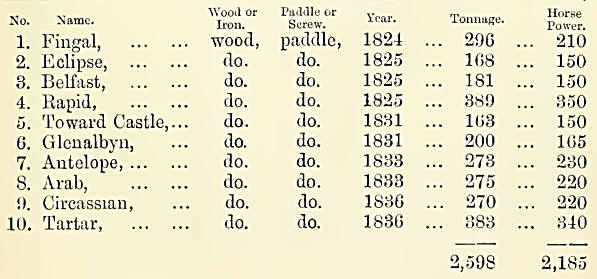
Glasgow and Belfast, Glasgow and Londonderry, and Glasgow and Larne
(continual).
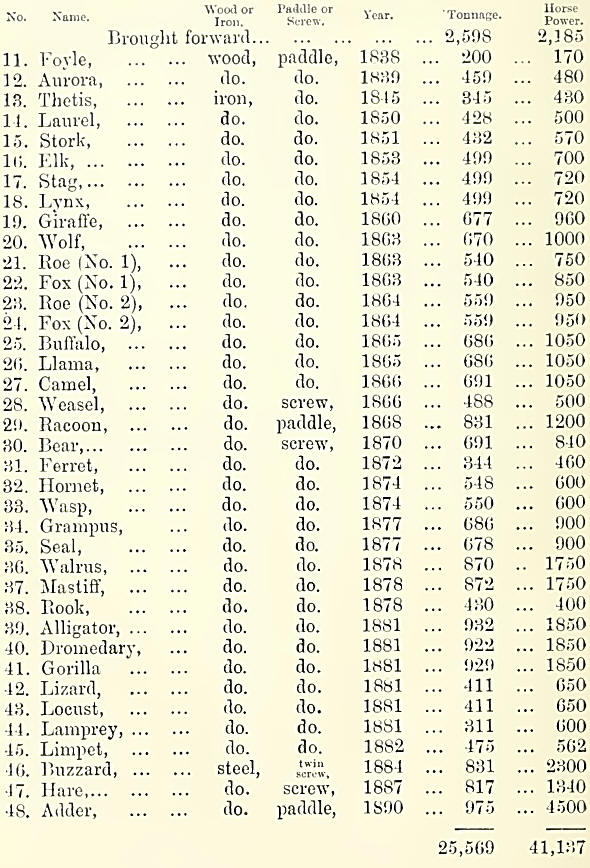
Glasgow and Liverpool.
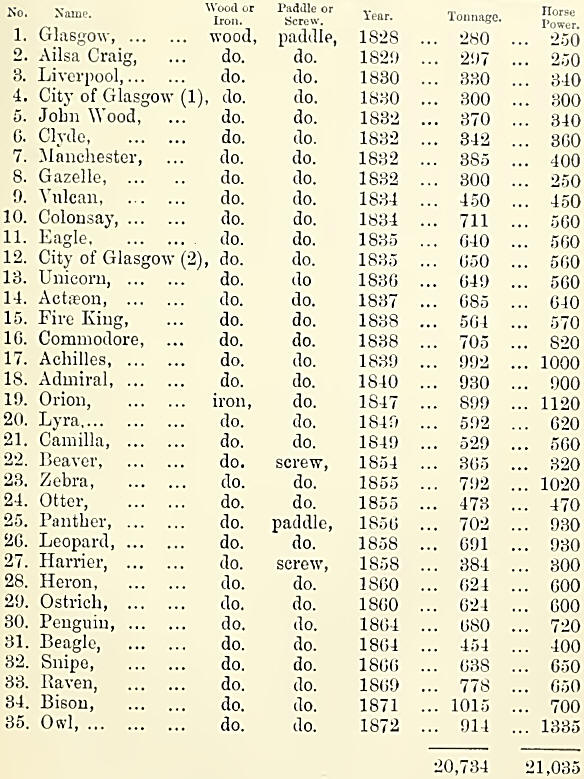
Glasgow and Highlands.
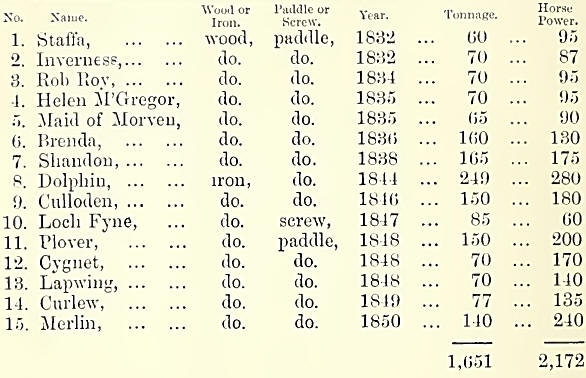
Glasgow and Firth of Clyde.
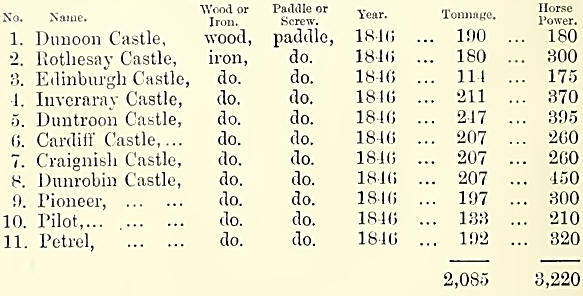
Liverpool and America.
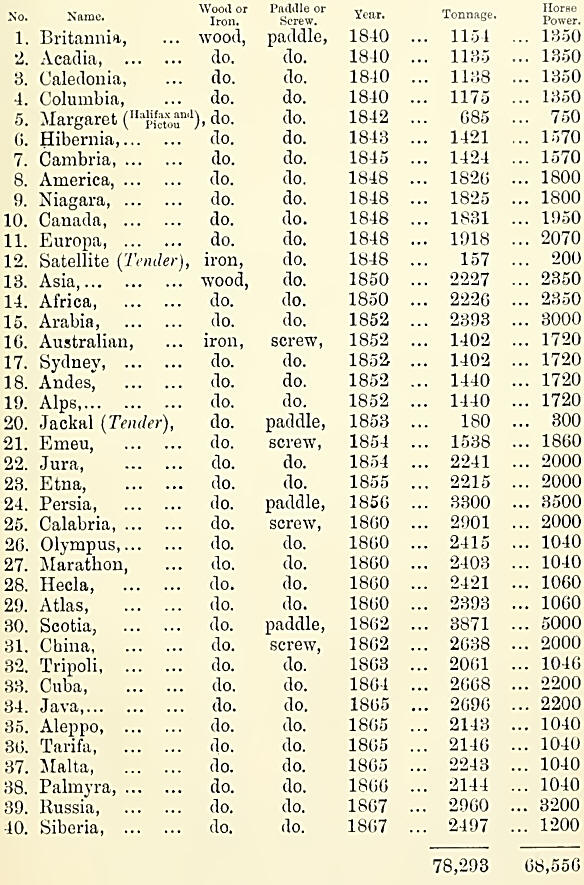
Liverpool and America (continued).
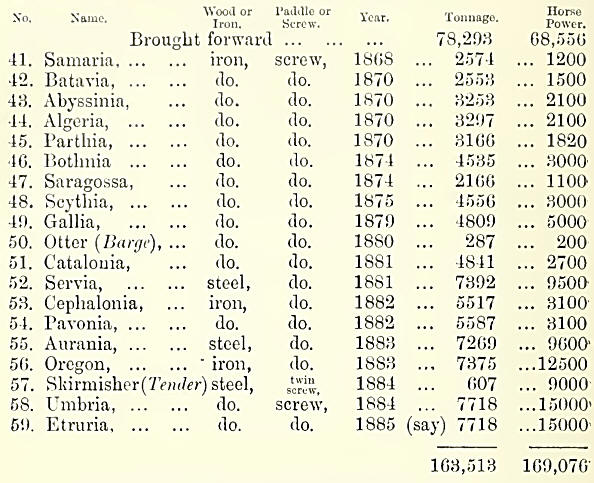
Liverpool and Mediterranean, and Liverpool and Havre.
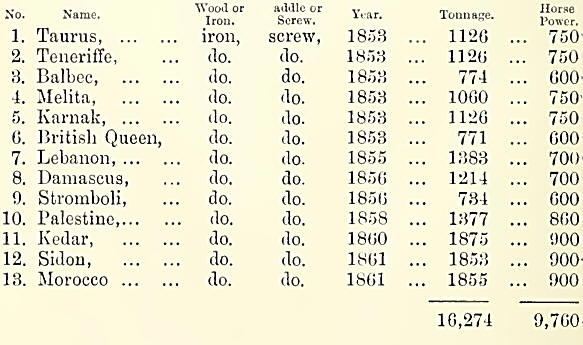
Livekpool and Mediterranean, and Liverpool and Havre (continued).
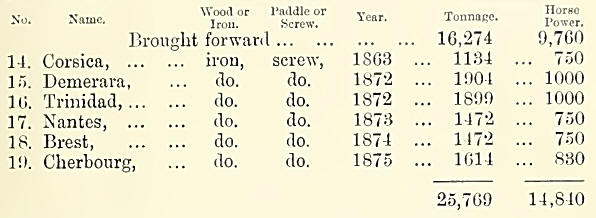
Steam Yachts Owned by Sir John Burns, Bart.

SUMMARY.
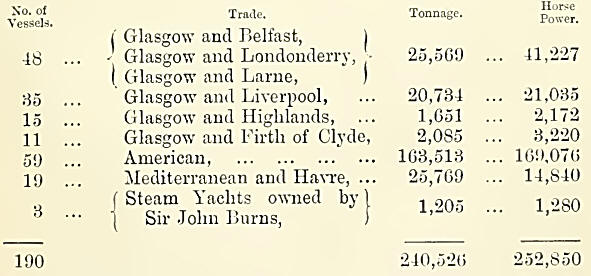
On the 11th of July, 1890, a few weeks after the death of Sir George
Burns, the Jubilee of the Cunard Company was celebrated. |

